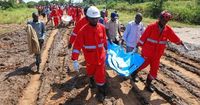It was a grim weekend in western Kenya’s Rift Valley, as the community of Chesongoch found itself at the heart of a natural disaster that has left families shattered and rescue teams racing against the elements. What began as heavy rains on Saturday, November 1, 2025, quickly escalated into a deadly landslide, claiming at least 26 lives and leaving another 25 people unaccounted for, according to government officials and multiple news reports including the Associated Press and South China Morning Post.
By Sunday, November 2, the situation had become even more dire. Search and rescue efforts, already hampered by washed-away roads and treacherous terrain, were abruptly suspended when flash floods swept through the area, putting both survivors and responders at further risk. Interior Minister Kipchumba Murkomen, addressing journalists, confirmed the tragic rise in the death toll and the suspension of rescue operations, stating, “It is very sad that families have lost five to six immediate family members.” The heartbreak in his words echoed the devastation felt across the region.
The disaster unfolded in Chesongoch, a hilly area in Elgeyo Marakwet county, where the relentless rains triggered a massive landslide. The aftermath was immediate and catastrophic: roads disappeared under torrents of mud and water, entire homes were swept away, and communities were cut off from the outside world. According to the BBC, the Kenyan government responded by deploying four military aircraft and disaster response teams to the area, which had become inaccessible by land. The military aircraft were not only tasked with ferrying rescue personnel but also with airlifting essential supplies and national examination papers to 15 schools isolated by the floods.
Oscar Okum, regional manager for the Kenya Red Cross, painted a picture of ongoing peril. “Today, while we were doing search and recovery and rescue, we have had roads that are already opened being populated again by mudslides. So it’s still an active incidence and we urge the community members to move to safer grounds for purposes of their safety, lives and livelihoods as well,” he told reporters. The warning was stark: the danger was far from over, with the saturated soil and persistent rains threatening further landslides.
As reported by Reuters, the government urged all residents living in flood or landslide-prone areas to relocate immediately, as the forecast predicted continued rainfall across the country. The message was clear—those who could move to safer ground needed to do so without delay. For many, however, the logistics of leaving behind their homes and livelihoods were daunting, especially with roads destroyed and entire villages isolated.
The human toll has been staggering. Families have been torn apart, with some losing as many as five or six relatives in a single day. More than 30 people sustained injuries during the disaster, and the government pledged to cover their medical bills. In addition, dozens of individuals who lost their homes would be resettled, according to statements from government spokesman Isaac Mwaura. The authorities’ commitment to support the affected was evident, but the scale of the tragedy meant that the road to recovery would be long and arduous.
As rescue teams battled the elements, the broader impact of the disaster became clear. Thousands of people across western Kenya have been displaced by ongoing flooding, with several counties affected. The government’s efforts to airlift supplies—everything from food and water to educational materials—highlighted the logistical challenges of responding to such widespread devastation. The military’s involvement underscored the severity of the crisis, as air support became the only means of reaching some of the most isolated communities.
The crisis in Kenya is not an isolated event. In the same week, neighboring Uganda also suffered deadly landslides, with at least 13 people killed in the east of the country, according to the Uganda Red Cross. Scientists and disaster experts have pointed to climate change as a key factor behind the increasing frequency and intensity of such extreme weather events in the region. As reported by the South China Morning Post, hundreds of people have lost their lives to landslides and flooding in Kenya in recent years. In the worst incident last year, 61 people were killed in a mudslide and flash floods in central Kenya.
Climate scientists warn that as global temperatures rise, East Africa is likely to experience even more unpredictable and severe weather patterns. This means heavier rains, more frequent flooding, and a higher risk of landslides—particularly in hilly or mountainous regions like the Rift Valley. The events in Chesongoch over the past weekend are a sobering reminder of the urgent need for disaster preparedness and climate adaptation strategies in vulnerable areas.
But while the causes of the disaster may be global, the effects are deeply personal. In Chesongoch and surrounding communities, families are mourning the loss of loved ones, searching for those still missing, and trying to piece together what remains of their homes and lives. The government’s promise to resettle the displaced and cover medical expenses offers some relief, but the emotional scars will linger long after the floodwaters recede.
For many residents, the immediate challenge is survival. With roads washed away and access to food, water, and medical care severely limited, the need for continued government support and international aid is pressing. The deployment of military aircraft and disaster response teams has undoubtedly saved lives, but the scale of the disaster means that recovery will require sustained effort and resources.
As the rains continue and the search for the missing resumes whenever conditions allow, the people of Chesongoch and western Kenya face an uncertain future. Their resilience is being tested like never before, but the outpouring of support from across the country and the world offers a glimmer of hope amid the devastation.
In a region already grappling with the effects of climate change, the events of this past weekend have underscored the urgent need for investment in disaster risk reduction, early warning systems, and community education. As Kenya mourns its dead and cares for its injured, the lessons learned from Chesongoch may help prevent future tragedies—or at least ensure that when disaster strikes, communities are better prepared to weather the storm.






